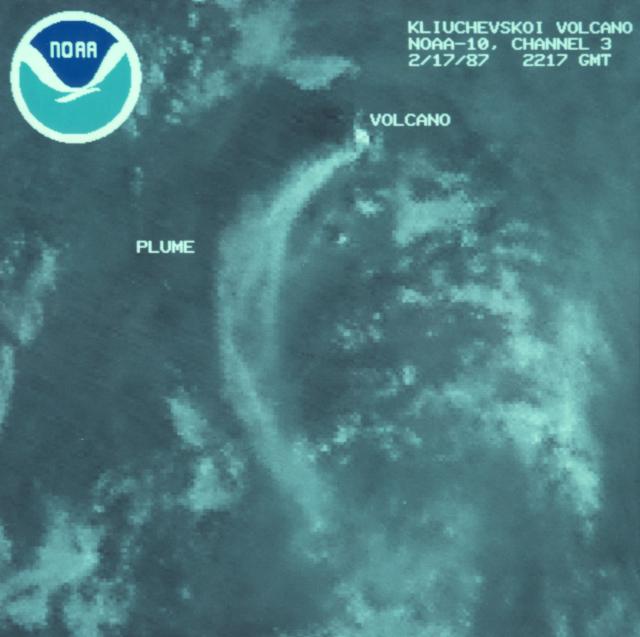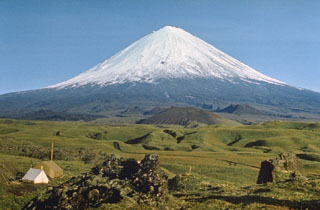Report on Klyuchevskoy (Russia) — February 1987
Scientific Event Alert Network Bulletin, vol. 12, no. 2 (February 1987)
Managing Editor: Lindsay McClelland.
Klyuchevskoy (Russia) Strong explosions; lava from flank fissure
Please cite this report as:
Global Volcanism Program, 1987. Report on Klyuchevskoy (Russia) (McClelland, L., ed.). Scientific Event Alert Network Bulletin, 12:2. Smithsonian Institution. https://doi.org/10.5479/si.GVP.SEAN198702-300260
Klyuchevskoy
Russia
56.056°N, 160.642°E; summit elev. 4754 m
All times are local (unless otherwise noted)
Soviet geologists reported that after intense summit crater explosive activity a NE-trending fracture (azimuth 135°) opened 24 February [but see 13:4] on the SE flank at 3,900-3,400 m altitude. Small amounts of lava were quietly emitted along the fracture. The flank eruption ceased on 26 February.
Small plumes had been intermittently visible on satellite images (figure 1) since 18 January. More vigorous activity was evident beginning 17 February and was almost continuous through 24 February (table 2). Maximum plume length was 500 km and maximum altitude may have reached 13.7 km.
 |
Figure 1. NOAA 10 thermal infrared (3.8 µm) satellite image on 18 February at 1017. A plume extends 65 km from Kliuchevskoi at ~3 km altitude. Courtesy of NOAA/NESDIS. |
Table 2. Descriptions of Kliuchevskoi plumes from infrared weather satellite images, 21-28 February 1987. Plume altitudes were estimated by comparing wind data from radiosondes launched 15 km N of the volcano with directions of plume movement.
| Date | Time | Altitude (km) | Length (km) | Direction | Satellite |
| 21 Feb 1987 | 1022 | 1.5-7.2 | 65 | ESE | NOAA 10 |
| 21 Feb 1987 | 1200 | 1.5-7.2 | 375 | ESE | GMS |
| 21 Feb 1987 | 1500 | 1.5-7.2 | 250 | ESE | GMS |
| 21 Feb 1987 | 1800 | 9.2-10.4 | 125 | E | GMS |
| 21 Feb 1987 | 2100 | 1.5-3.0 | 150 | E | GMS |
| 22 Feb 1987 | 0000 | 1.5-3.0 | 440 | E | GMS |
| 22 Feb 1987 | 0600 | 3.0 | 125 | E | GMS |
| 22 Feb 1987 | 0900 | 5.6-11.8 | 250 | ENE | GMS |
| 22 Feb 1987 | 1031 | 9.2-13.7 | 105 | ENE | NOAA 10 |
| 22 Feb 1987 | 1200 | 9.2-13.7 | 440 | ENE | GMS |
| 22 Feb 1987 | 1500 | 9.2-13.7 | 500 | ENE | GMS |
| 22 Feb 1987 | 1800 | 5.6-10.4 | 500 | ENE | GMS |
| 22 Feb 1987 | 2100 | 5.6-10.4 | 500 | ENE | GMS |
| 23 Feb 1987 | 0000 | 10.4-11.8 | 310 | ENE | GMS |
| 23 Feb 1987 | 0300 | -- | cloudy | -- | GMS |
| 24 Feb 1987 | 0600 | -- | cloudy | -- | GMS |
| 24 Feb 1987 | 0900 | 5.6 | 190 | NW | GMS |
| 24 Feb 1987 | 1448 | 5.6 | 125 | NW | NOAA 9 |
| 24 Feb 1987 | 1500 | 5.6 | 500 | NW | GMS |
| 24 Feb 1987 | 1800 | 3.0 | 500 | NW | GMS |
| 24 Feb 1987 | 2100 | 3.0 | 500 | NW | GMS |
| 28 Feb 1987 | 0442 | -- | 20 | WSW | NOAA 9 |
Geological Summary. Klyuchevskoy is the highest and most active volcano on the Kamchatka Peninsula. Since its origin about 6,000 years ago, this symmetrical, basaltic stratovolcano has produced frequent moderate-volume explosive and effusive eruptions without major periods of inactivity. It rises above a saddle NE of Kamen volcano and lies SE of the broad Ushkovsky massif. More than 100 flank eruptions have occurred during approximately the past 3,000 years, with most lateral craters and cones occurring along radial fissures between the unconfined NE-to-SE flanks of the conical volcano between 500 and 3,600 m elevation. Eruptions recorded since the late 17th century have resulted in frequent changes to the morphology of the 700-m-wide summit crater. These eruptions over the past 400 years have originated primarily from the summit crater, but have also included numerous major explosive and effusive eruptions from flank craters.
Information Contacts: A. Khrenov, IV; M. Matson and W. Gould, NOAA/NESDIS.

